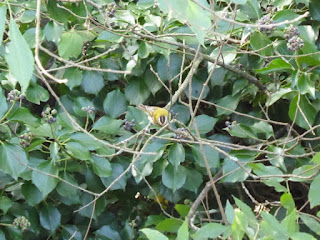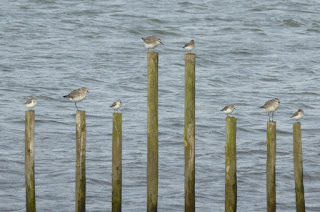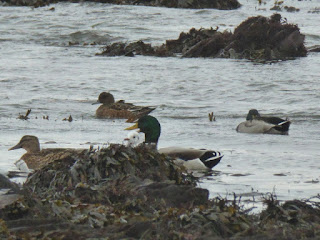Wet, warm and windy weather of late has precluded any real birding with the only thing of note being my first 2 little grebes of the winter on Sutton Harbour on November 19th along with 7 mute swans - the RSPCA had caught and relocated the mute swans in the harbour in the spring due to concerns about pollution and lack of natural food availability but it looks like they are slowly migrating back.
November 22nd was a pleasent contrast - cold, clear and calm - but my planned trip to Wembury for a walk went out of the window when I realised that there are no buses to Wembury on Sundays since Stagecoach took over from First Bus. Instead I caught the train to Dawlish Warren and had a very enjoyable wander around. It was low tide when I arrived so I concentrated on the sea and land instead of the estuary and as the day progressed it became pleasently warm - it was still a surprise though to see a swallow flying along the beach towards Exmouth, my second latest sighting ever.
On a flat calm sea I managed distant and heat hazy views of a great northern diver and a red throated diver with much better views of 2 female goldeneye with 2 female red breasted mergansers closer to shore. A flock of around 20 common scoter were flighty and mobile around the bay and a flock of around 30 teal roosting on the sea was a surprise. 2 great crested grebes were also seen and I eventually found another red throated diver close to shore, this one was a juvenile with a duskier head and neck than the adult I had seen earlier and with a buffy coloured throat patch.
It was quieter on land with 2 chiffchaffs in the trees around the main pond, water rails heard squealing in the waterside reeds, a pair of stonechat, a great spotted woodpecker and a female reed bunting being the highlights.
On checking the bird sightings in the evening on November 26th and a yellow browed warbler was reported in Beaumont Park, right on my doorstep, but unfortunately the next morning I was due to head off early on the train to Suffolk to visit my parents. I had a quick walk around the park before heading off to the railway station but didn't find it although I did find 2 coal tits, 2 goldcrests, long tailed tits, a flyover grey wagtail and a calling nuthatch, my first in the park.
The train journey to London was uneventful although 30 minutes late into Paddington and I had some brief and distant views of red kites between Westbury and London on what was another grey and windy day.
The following day and my Mum had to work and so we had the use of her car for the day. I wasn't sure where to head too, my plan to visit Minsmere was ditched when I realised I had left my membership card and free visitors pass at home and I wasn't going to pay £16 for the 2 of us to get in. A red necked grebe at Alton Water, not far from Mums house, was an option but I eventually decided to head to Ampton near Bury St.Edmunds instead to look for tree sparrows that are frequently reported in the winter on the Suffolk BINS website. I wasn't sure where to look for the tree sparrows and searching the internet for more information gave few clues but it seemed that the birds were mostly seen on bird feeders in the village gardens. Google Maps highlighted the few houses with gardens in the village and so I was able to narrow down my search area. I also found some reports of yellow legged gulls and Caspian gulls at a nearby pig farm and so decided to include a visit there on my walk.
David dropped me off in the village before heading off to look around the antique shops at Risby, giving me around 2 hours to explore the area by myself. It was a grey and windy day but dry and I wandered off checking out all the gardens for any sign of tree sparrows. Eventually I found an isolated row of cottages surrounded by trees and hedges and there they were, a flock of around 50 tree sparrows, noisey but skulking in the vegetation and regularly flying around - very nice to see as I rarely see them and have never seen them here in Devon.
Tree Sparrow
Tree Sparrow
Tree Sparrows
Also seen with them were blue tits, great tits, chaffinch, goldfinch, a male yellowhammer, redpoll and at least 3 bramblings, while in the nearby fields there were lots of pheasents and red legged partridges.
Male Brambling
I then headed off towards the pig farm, walking along the road in a flat and open landscape. Nearing the farm and I could see lots of large gulls roosting amongst the pigs but I made the mistake of stopping to scan them with my binoculars and they all took to the air. Fortunately they quickly settled again but further away and so I headed to a small wood by the road where I would be less obvious and this time the gulls didn't take flight again as I stopped to look at them. Scanning through them and I instantly found what I was looking for - a smart 1st winter Caspian gull, its white head and underparts standing out like a beacon amongst the herring, lesser black backed and black headed gulls and a life tick for me too.
1st Winter Caspian Gull - top right
As I watched it a nearby shooting party began blasting pheasents and red legged partridges out of the sky and all the gulls took to the air again. I watched the Caspian gull fly off and noted its white rump and black tail band before it landed again nearer to where I was standing. I then had some good views of it before a tractor came rattling along the road putting up all the gulls again and off it flew, never to be seen again, but I was very pleased to have seen it.
1st Winter Caspian Gull - top left
Caspian Gull
Caspian Gull
After all the gull and sparrow and finch excitement the rest of the trip was uneventful and so it was off to Cologne for a few days on Monday 30th to eat and drink too much on the Christmas markets. Birdwise it was quiet but I did see collared dove, woodpigeon, feral pigeon, magpie, carrion crow, greenfinch, blackbird, starling, blue tit, black headed gull, fieldfare and ring necked parakeet from the hotel room window, not bad for the centre of Cologne. I also saw buzzard, mute swan, Canada goose, coot and jackdaw on our train journeys and arriving back in the UK on Saturday 5th December I saw a single ring necked parakeet flying over the M4 on the drive back to Plymouth, a nice end to a busy week away.
Cologne Christmas Market
Aachen Cathedral
Aachen Cathedral











































